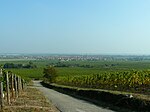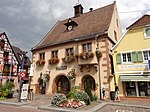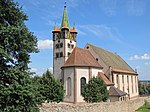St. Faith's Church, Sélestat

The Church of Saint Faith of Sélestat (French: Église Sainte-Foy de Sélestat, German: Sankt-Fides-Kirche) is a major Romanesque architecture landmark in Sélestat along the Route Romane d'Alsace in the East of France. The church having been built over a very short time span (only ten years, from 1170 to 1180), it appears strikingly homogenous in style and proportions, however some parts have been completed and others modified in a Romanesque Revival style by the architect Charles Winckler (sometimes spelled Winkler) between 1889 and 1893. During that restoration campaign, a crypt dating back to around 1085 was discovered and made accessible as well. Like many major buildings in Alsace the church is made of pink Vosges mountains sandstone.
Excerpt from the Wikipedia article St. Faith's Church, Sélestat (License: CC BY-SA 3.0, Authors, Images).St. Faith's Church, Sélestat
Rue Sainte-Foy, Sélestat-Erstein
Geographical coordinates (GPS) Address Nearby Places Show on map
Geographical coordinates (GPS)
| Latitude | Longitude |
|---|---|
| N 48.259166666667 ° | E 7.4561111111111 ° |
Address
École primaire Sainte-Foy
Rue Sainte-Foy
67600 Sélestat-Erstein
Grand Est, France
Open on Google Maps









